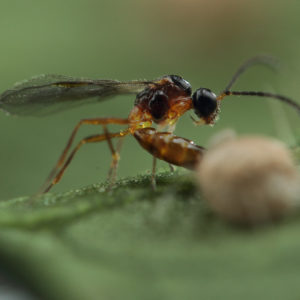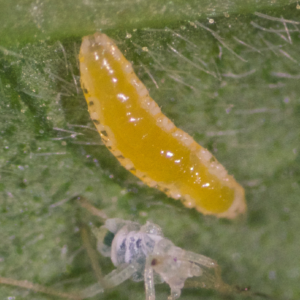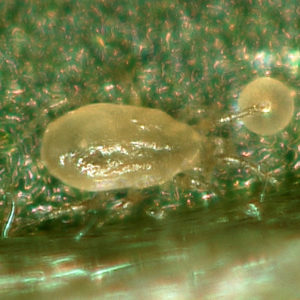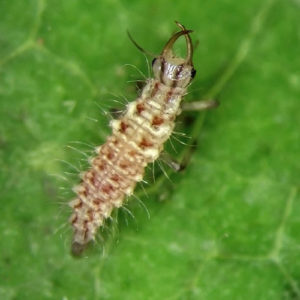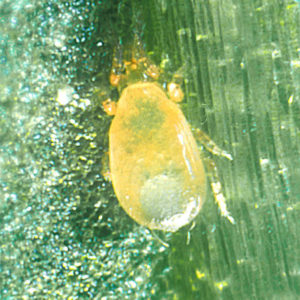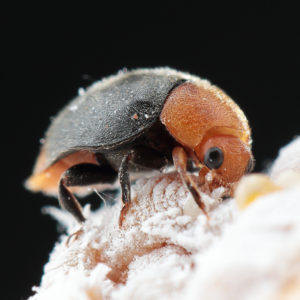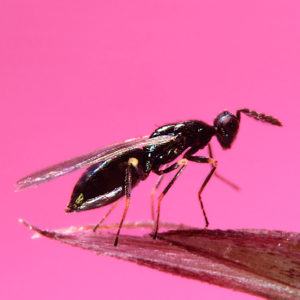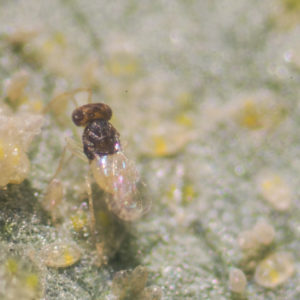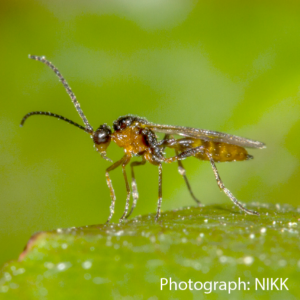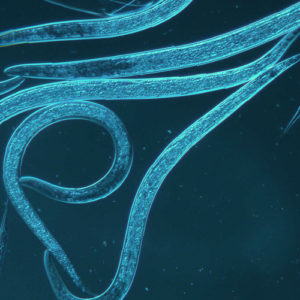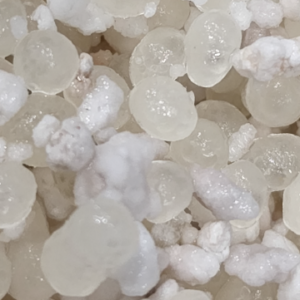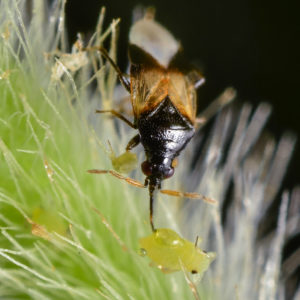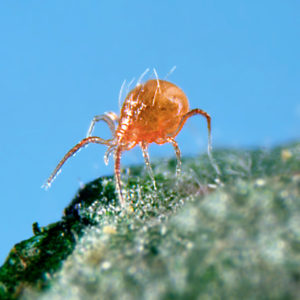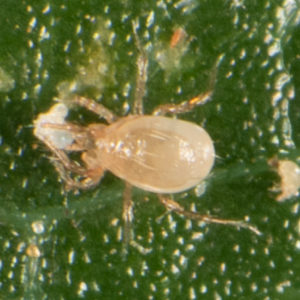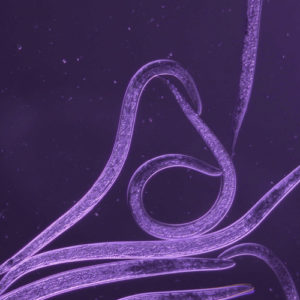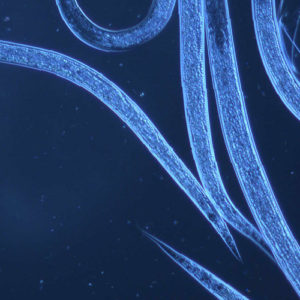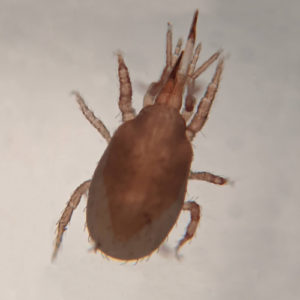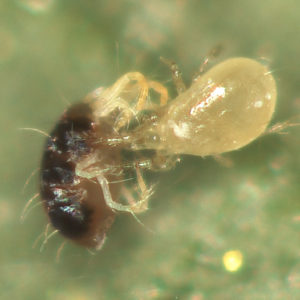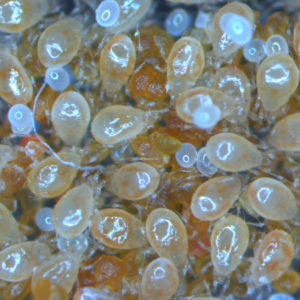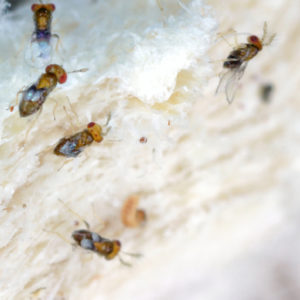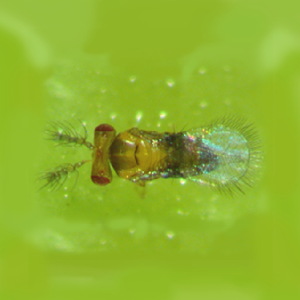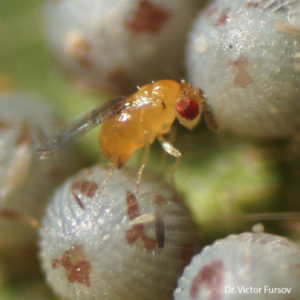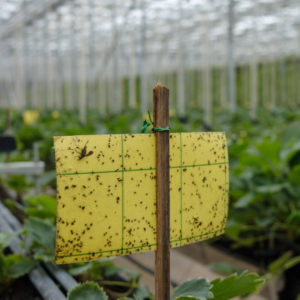BioAndersoni (Amblyseius andersoni) is a predatory mite that feeds on small arthropod prey and pollen.
BioAphidius
BioAphidius (Aphidius colemani) is a parasitic wasp. This polyphagous parasitoid attacks over 40 species of aphids.
BioAphidoletes
BioAphidoletes (Aphidoletes aphidimyza), commonly referred to as the gal midge, is a midge whose larvae feed on over 70 aphid species. Adults are small, delicate, mosquito-like flies with long, dangling legs and long antennae.
BioAtheta
BioAtheta (Dalotia coriaria) is a fast-moving, soil dwelling rove beetle. A generalist predator, it feeds on a wide range of small insects and mites but is primarily an egg predator. BioAtheta is used in the control of fungus gnats, thrips pupae, shore flies, moth fly larvae, root mealybugs, springtails and other small arthropods.
BioCalifornicus
BioCalifornicus (Neoseiulus californicus) is an effective predatory mite of a wide array of pest mites.
Cali Combo
Cali Combo contains BioCalifornicus (Neoseiulus californicus) and BioClFeed (Carpoglyphus lactis) which helps to establish and maintain a large and stable N. californicus population before pests appear.
BioCarnea (lacewing)
BioCarnea (Chrysoperla carnea) is an insect of the Chrysopidae family. The delicate looking adult feeds on nectar and pollen while the larvae of BioCarnea is the active predator. The first three larvae instars, are the voracious ones.
BioCucumeris
BioCucumeris (Neoseiulus cucumeris) is a predatory mite widely used in the control of immature thrips (egg and larvae) as well as other species of mites.
BioCryptolaemus
BioCryptolaemus (Cryptolaemus montrouzieri) is a predatory beetle, also known as the “Mealybug destroyer” because it is a voracious predator of multiple species of mealybugs in both greenhouses and open fields.
BioDiglyphus
BioDiglyphus (Diglyphus isaea) is an ectoparasitic wasp that parasitizes leaf miner larvae in field and greenhouse crops.
BioEncarsia
BioEncarsia (Encarsia formosa) is a parasitic wasp of the Aphelinidae family. E. formosa can utilize at least 15 species of whitefly as hosts but the principal host is the greenhouse whitely.
BioEretmocerus
BioEretmocerus (Eretmocerus eremicus) is a parasitic wasp used for the control of sweet potato whitefly and greenhouse whitely.
BioErvi
BioErvi (Aphidius ervi) is an effective parasitic wasp for larger aphid species that are not effectively controlled by Aphidius colemani such as potato aphids (Macrosiphum euphorbiae), foxglove aphids (Aulacorthum solani) as well as pea aphids (Acyrthosiphon pisum) and can also parasitize cannabis aphids (Phorodon cannabis) .
BioHb
BioHb is an Entomopathogenic nematode containing infective juveniles of Heterorhabditis bacteriophora in an inert carrier.
BioMaculata
BioMaculata, also called the pink spotted lady beetle or twelve-spotted lady beetle is a voracious predator. Both the larva and the adult beetle are important aphids predators of pea aphids (Acyrthosiphon pisum), green peach aphids (Myzus persicae), cotton aphids (Aphis gossypii), cabbage aphids (Brevicoryne brassicae), and potato aphids (Macrosiphum euphorbiae).
nemaplus® Depot
BioNephus (Nephus bipunctatus) is a generalist predator of mealybugs and prefers to feed on smaller mealybug life stages and eggs.
BioOrius (insidiosus)
BioOrius (Orius insidiosus) also known as the insidiosus flower bug, is a predatory minute pirate bug equipped with piercing-sucking rostrum and two pairs of wings, the front pair being partially rigid.
BioPersimilis
BioPersimilis (Phytoseiulus persimilis) is a predatory mite, proven outstanding, aggressive and highly effective against spider mites. The adult female is a distinctive reddish-orange color with a pear-shaped body.
BioPersi+
BioPersi+ (Phytoseiulus persimilis), a proven aggressive and highly effective predator of spider mites, was developed at BioBee with an innovative technology which won BioBee the Bernard Bloom Innovation Award.
BioSf
BioSF is an Entomopathogenic nematode containing infective juveniles of Steinernema feltiae in an inert carrier .
BioSc
BioSc is an Entomopathogenic nematode containing infective juveniles of Steinernema carpocapsae in an inert carrier.
BioStratio
BioStratio (Stratiolaelaps scimitus) is a soil-dwelling predatory mite whose nymphs and adults feed on fungus gnat larva, thrips pupae and other small invertebrates. These predatory mite stay at the base of plant stems and on the soil, rarely transferring onto the plant itself.
BioSwirski
BioSwirski (Amblyseius swirskii) is an efficient predatory mite used for the control of young stages of the western flower thrips as well as the eggs and young nymphs of white flies. It also feeds on red spider mites as well as on broad mites.
BioSwirski Combo
BioSwirski Combo contains the predatory mite Amblyseius swirskii and BioArtFeed, premium quality decapsulated Artemia cysts ( brine shrimp eggs). BioSwirski is a proven and highly effective predator, while BioArtFeed enables its early establishment.
BioTrichobrassicae
BioTrichobrassicae (Trichogramma brassicae) is an egg parasitoid used in IPM programs to control various lepidopteran pests. The adult T. brassicae measures around 0.3 mm and is pale yellow with red eyes.
The female lays its eggs in lepidopteran eggs and can parasitize up to ten eggs a day. The larva kills the developing embryo of the host and feeds on the egg contents. After the pupation stage it emerges as an adult, through a circular hole in the egg. The adult wasp is able to mate shortly after emerging.
BioTricho Mix
BioTricho Mix (Trichogramma brassicae, Trichogramma ostrinae, Trichogramma minutum) contains three different species of Trichogramma, egg parasitoids used in IPM programs to control various lepidopteran pests. This product is recommended for use when you are unsure of the species of caterpillars present in the crop. The females lay their eggs in lepidopteran eggs and can parasitize up to ten eggs a day. The larva kills the developing embryo of the host and feeds on the egg contents. After the pupation stage it emerges as an adult, through a circular hole in the egg. The adult wasp is able to mate shortly after emerging.
BioTrichoostriniae
BioTrichoostriniae (Trichogramma ostriniae) is an egg parasitoid used in IPM programs to control various lepidopteran pests. The adult T. ostriniae measures around 0.3 mm and is pale yellow with red eyes.
The female lays its eggs in lepidopteran eggs and can parasitize up to ten eggs a day. The larva kills the developing embryo of the host and feeds on the egg contents. After the pupation stage it emerges as an adult, through a circular hole in the egg. The adult wasp is able to mate shortly after emerging.
BioTrichoostriniae is recommended for use in peppers, hops, sweet corn and hemp/cannabis.
BioTrichominutum
BioTrichogramma (Trichogramma cryotophlebiae) is a parasitic wasp for the control of the False codling moth (Thaumatotibia leucotreta) and the Macadamia nut borer (Thaumototibia batrachopa).
BioTrichopretiosum
BioTrichopretiosum (Trichogramma pretiosum) is an egg parasitoid used in IPM programs to control various lepidopteran pests. The adult T. pretiosum measures around 0.3 mm and is pale yellow with red eyes. The female lays its eggs in lepidopteran eggs and can parasitize up to ten eggs a day. The larva kills the developing embryo of the host and feeds on the egg contents. After the pupation stage it emerges as an adult, through a circular hole in the egg. The adult wasp is able to mate shortly after emerging.BioTrichopretiosum is recommended for use in cranberry, ornamentals, peppers and cabbage.
Traps
Traps are a useful tool for mass capture, monitoring, counting and identifying pests. Some traps are coated with an adhesive (on one side) while others are plant derived semiochemicals or pheromone baited.

